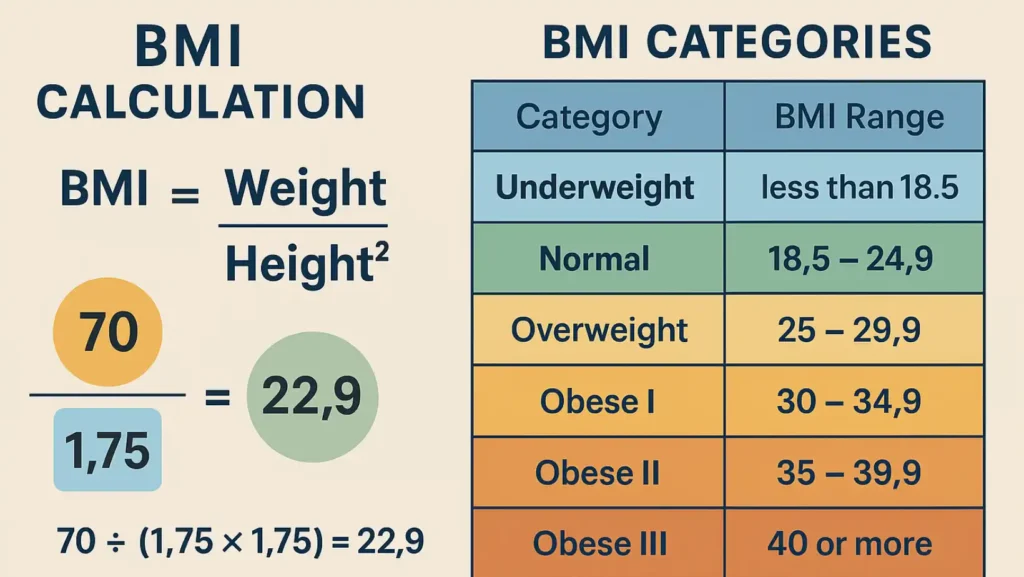The body mass index is one of the simplest ways to know if your weight is healthy for your height. The BMI is a number that shows the balance between your body weight and your height. The BMI is weight in kilograms divided by height in meters squared.
Table of Contents
ToggleThough it sounds simple, the BMI calculation has been used for decades to guide doctors, health workers, and even fitness experts. If you ever wondered, “what is my BMI?”, the good news is you can find it with a basic formula or an online calculator. Tools like BMI calculator men and BMI calculator women are now widely available to give quick answers.
Overview
What Is Body Mass Index (BMI)?
BMI meaning is a score that links your weight with your height. The BMI definition explains it as a weight-to-height ratio that falls on a standard BMI scale.
A lower number often means you are underweight, a middle number points to normal weight, and higher numbers show you are overweight or even obese. Doctors use BMI interpretation to group people into these ranges.
This number is not a complete measure of your health. Instead, it works as an early clue to your risk level. For most people, the body mass index is a quick and useful screening tool.
What Is BMI Used For?
The BMI is used in two key ways:
- Diagnosing weight types with BMI
- Screening for health risks with BMI
Diagnosing Weight Types With BMI
When you know your BMI, your doctor can place it into a category called BMI classifications (underweight, optimum, overweight, Class I–III obesity).
Here is a BMI classification table to help you see where you fit:
| Category | BMI Range | Health Notes |
| Underweight | Less than 18.5 | May signal malnutrition, anemia, osteoporosis risk |
| Normal weight | 18.5 – 24.9 | Often linked with lower disease risk |
| Overweight | 25 – 29.9 | Higher risk for heart disease, type 2 diabetes |
| Obese (Class I) | 30 – 34.9 | Raised risk of hypertension and gallstones |
| Obese (Class II) | 35 – 39.9 | Risk for sleep apnea, osteoarthritis, cancers |
| Obese (Class III) | 40 or more | Very high risk for cardiovascular disease |
Screening For Health Risks With BMI
A high or low BMI can point to medical risks.
- High BMI can be linked with obesity problems such as heart disease, high blood pressure (hypertension), type 2 diabetes, gallstones, osteoporosis, osteoporosis, and even some cancers (colon, breast, endometrial, gallbladder).
- People with obesity are also at higher risk for sleep apnea, osteoarthritis, and depression / mental health conditions.
- A very low BMI may signal malnutrition, anemia, a weakened immune system, or infertility.
Doctors use BMI as a first step. After this, they may order tests like a comprehensive metabolic panel or a lipid panel to measure cholesterol and blood sugar.
BMI Calculation
How Do I Calculate My BMI?
The BMI calculation is simple math.
- Take your weight in kilograms.
- Measure your height in meters.
- Divide weight by height squared.
| For example: If you weigh 70 kilograms and are 1.75 meters tall: That value (22.9) is in the “normal weight” range. In pounds and inches, use the formula: |
The BMI calculation works the same for adults of all ages. But children and teenagers need age-specific growth charts, and older adults (65+) may require extra checks since muscle loss, called muscle atrophy, can make BMI less accurate.
What Is My BMI? Using BMI Calculator For Men And BMI Calculator For Women
A man BMI calculator will ask for your weight and height and show your range. It often includes risks common in men, such as cardiovascular disease or dyslipidemia (high cholesterol).
A BMI calculator does the same, but it may highlight conditions women face more often, like osteoporosis, infertility, or hormone-linked health risks.
Both calculators use the same BMI calculation. They simply present health notes that matter more to men or women.
Healthy Ranges
What Is A Healthy BMI?
For most adults, a healthy BMI sits between 18.5 and 24.9. This is the “normal” range.
- Under 18.5: underweight
- 18.5 to 24.9: normal weight
- 25 to 29.9: overweight
- 30 and above: obese
The BMI scale is universal, but results must be paired with other factors. Your body composition, waist circumference, and lifestyle also matter. A healthy BMI lowers risk for long-term diseases, but it is not the only number that counts.
Limitations
What Are The Limitations Of BMI?
While BMI is widely used, there are many limitations of BMI.
- It does not measure body fat directly.
- It cannot separate muscle mass from fat.
- Athletes may show “obese” BMI despite being lean.
- BMI does not reveal fitness and BMI levels.
- It cannot check where fat is stored. Belly fat, for example, raises risk more than thigh fat.
Limitations Of Using BMI To Diagnose Weight Types
When used to classify weight, BMI sometimes mislabels people.
- A bodybuilder may have a BMI of 32 but very low body fat.
- An older adult may have “normal” BMI yet suffer from muscle atrophy and high fat levels.
- Children / teenagers need age-adjusted charts.
BMI cannot tell if your weight comes from muscle or fat. It is only a first filter.
Limitations Of Using BMI As A Screening Tool For Health Conditions
When doctors use BMI to screen disease, they know it is not enough.
- Blood tests such as a comprehensive metabolic panel or lipid panel show better health markers.
- Waist size, tested by waist circumference, gives more detail about fat risk.
- Tools like skinfold calipers and high-tech scans like DEXA scan / ADP (air displacement plethysmography) are better for true body composition.
- Factors like genetics and lifestyle also affect health.
BMI should never be the only measure of risk. It should be combined with other health indicators.
The Bottom Line
The body mass index is quick, cheap, and simple. The BMI definition is only a formula, but that number can point to serious risks. It has links to cardiovascular disease, high blood pressure (hypertension), type 2 diabetes, osteoporosis, cancers, and depression / mental health conditions.
But BMI is not perfect. It cannot tell the full story of body composition, muscle, or fat distribution. It misses unique risks for groups like older adults (65+), children, or athletes.
The best use of BMI is as a first step. Doctors often pair it with blood tests, waist size checks, and scans. They also consider family history and genetics.
A healthy life cannot be summed up by one number. BMI is a guide, not a final answer. To protect your health, focus on good food, daily movement, regular sleep, and mental well-being.
FAQs
How do I calculate my BMI?
You divide weight by height squared. Use kilograms and meters, or pounds and inches with the 703 factor. Or use an online BMI calculator for women or men tool.
What is the body mass index?
The body mass index is a weight-to-height ratio. It is a screening test used to place you in a category like underweight, normal, overweight, or obese.
What is a normal BMI index?
A normal BMI sits between 18.5 and 24.9. This range shows lower risk for diseases. Numbers below or above may signal underweight or overweight conditions.
Why do doctors still use BMI?
Doctors use BMI because it is simple, fast, and low cost. It helps find people at risk. It is not perfect, but it is still useful for screening.
What is good BMI for females?
A good BMI for women is in the “normal” range of 18.5 to 24.9. Beyond BMI, women should also track waist size and bone health for better risk checks.
What is a healthy body fat percentage?
Healthy body fat varies by sex and age. BMI does not show body fat. Tools like DEXA scan or skinfold calipers give more precise results than BMI alone.
How is BMI calculated automatically?
Online calculators ask for your weight and height. Then they run the BMI calculation formula automatically. The result is paired with a BMI interpretation scale.

This article is medically reviewed by Dr. Chandril Chugh, Board-Certified Neurologist, providing expert insights and reliable health information.
Dr. Chandril Chugh is a U.S.-trained neurologist with over a decade of experience. Known for his compassionate care, he specializes in treating neurological conditions such as migraines, epilepsy, and Parkinson’s disease. Dr. Chugh is highly regarded for his patient-centered approach and dedication to providing personalized care.









